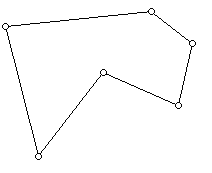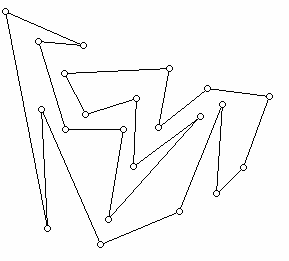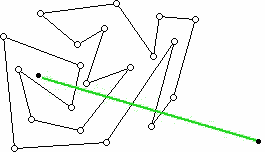Diagonals: Part I
2. What is a diagonal?
Nearly everyone is familiar with the term diagonal to describe the line segment (shown in blue below) cutting across a rectangle or a square:

A rectangle has two diagonals of the same length. In mathematics the observation of a "fact" is often the force behind asking new questions. Are there rectangles whose diagonals are perpendicular and equal in length? Yes, these are the special rectangles called squares. Are there 4-gons whose diagonals are perpendicular but not equal in length? Yes, these are the 4-gons which are rhombuses but not squares. A rhombus is a (convex) 4-gon with equal side lengths. We use the word "diagonal" not only for plane polygons (2-dimensions) but also for lines joining corners of a "box" (3-dimensions). In this column we will concentrate on issues involving diagonals of plane figures.
A more general definition of a diagonal of a polygon is a line segment that joins two vertices of the polygon which are not already joined by an edge of the polygon. Should we refer to the blue line below as a diagonal of a self-intersecting polygon, or should we require that diagonal only be defined for polygons which have no self-intersection, and where the diagonal lies totally within the region defined by the polygon?

Since we might want the blue line below, for a non-convex polygon (here a quadrilateral) to be thought of as diagonal, we should keep the definition of "diagonal" fairly general.

What makes mathematics unusual is that it is a subject in which new words can be defined (or old words can be used in special ways) for reasons internal to the subject. Whereas biologists study phenomena imposed on them by investigating the world as it is, mathematicians to some extent investigate worlds of their own creation. In deciding good ways to define words, mathematicians look to the range of phenomena that are captured by allowing abstractions and generalizations of familiar ideas, but which in the more abstract situation seem a bit "weird." Abstraction often leads to more far-ranging results and unexpected phenomena. The geometer Branko Grünbaum has dealt with the problem of "types of diagonals" by using a new word to distinguish situations when one has a plane non-self-intersecting polygon. He uses the term diagonal for a segment joining two vertices of the polygon which lies totally in the interior of the polygon and epigonal for a line segment lying totally in the exterior of the polygon. Note that in this view, in addition to diagonals and epigonals, there may be segments which are partly in the interior and partly in the exterior.
Our first examples of diagonals, those of rectangles, squares and rhombuses, are diagonals of metric geometric figures. These are figures for which we measure distances and angles. However, much of the discussion that follows concerns diagonals in combinatorial settings, where we are not specifically interested in distance issues.
Suppose we have a plane polygon P, convex or not, that does not intersect itself. A typical example of such a (non-convex) polygon is shown below:

Polygons that have three consecutive vertices x, y, and z where the angle at y is 180 degrees (i.e. x, y, and z lie along a straight line) are a bit of a nuisance, and we will not allow them. (Sometimes it is even insisted that no three points of the polygon lie on a straight line.) By the Jordan Curve Theorem, a non-self-intersecting polygon, usually called a simple polygon, divides the points of the plane not on the polygon itself into two sets: the inside of the polygon and the outside. If we restrict ourselves to drawing diagonals that lie totally in the interior of the polygon, it is clear that we can find such diagonals for this polygon. Such a diagonal of a simple polygon will be called an interior diagonal. Is it possible that a polygon be so convoluted that it would be impossible to find a single diagonal which lies totally in its interior?

Figure 1
For a very convoluted polygon such as the one above, it is perhaps not entirely clear that there is always an interior diagonal. Finding an interior diagonal is the first step in showing that every plane simple polygon can be triangulated. This means that interior diagonals can be added which result in all the interior faces of the resulting structure having three sides. For a very convoluted polygon it may not even be clear which points are inside the polygon and which ones are outside. There is an easy way to determine this. Start at any point outside the polygon. Now draw a line segment from this point to the point in question. Count the number of times this line segment intersects the polygon. If this number is even, the point in question is outside the polygon. If this number is odd, the point is inside the polygon!
In the diagram above, the green line cuts the polygon in 5 places so the point whose interior vs. exterior status might be unclear must be inside the polygon.
-
Introduction
-
What is a diagonal?
-
Triangulations and ears
-
Art gallery theorems
-
Where do new problems come from?
-
References








